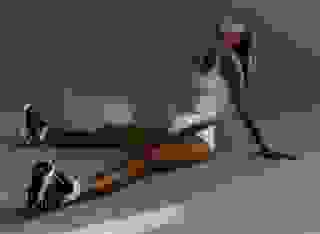Note: You can change font size, font face, and turn on dark mode by clicking the "A" icon tab in the Story Info Box.
You can temporarily switch back to a Classic Literotica® experience during our ongoing public Beta testing. Please consider leaving feedback on issues you experience or suggest improvements.
Click here7. Hymns to Goddess Nemesis
There is a Hymn to Goddess Nemesis, known as Orphic Hymn 61 from a collection of Greek hymns from 3rd century B.C. to 2nd century A.D.
Orphic Hymn 61: Hymn to Nemesis
Thee, Nemesis, I call, almighty queen, by whom the deeds of mortal life are seen;
eternal, much revered, of boundless sight, alone rejoicing in the just and right;
changing the counsels of the human breast for ever various, roiling without rest.
To every mortal is thy influence known, and men beneath thy righteous bondage groan;
for every thought within the mind concealed is to thy sight perspicuously revealed.
The soul unwilling reason to obey, by lawless passion rule, thine eyes survey.
All to see, hear and rule, O power divine, whose nature equity contains, is thine.
Come, blessed, holy Goddess, hear my prayer, and make thy mystics' life thy constant care;
give aid benignant in the needful hour, and strength abundant to the reasoning power;
and far avert the dire, unfriendly race of counsels impious, arrogant, and base.
Hymn to Nemesis – Mesomedes
Mesomedes of Crete, a Greek lyric poet wrote a 'Hymn to Nemesis'. He lived during the 2nd century and was a freedman and court musician to the emperor Hadrian (117-138). The hymn to Nemesis is one of only four which preserve the ancient notation written over the text. Prior to the discovery of the Seikilos epitaph in the late 19th century the hymns of Mesomedes were the only surviving written music from the ancient world.
Winged Nemesis, turner of the scales of life,
blue-eyed goddess, daughter of justice,
who, with your unbending bridle,
dominate the vain arrogance of men and,
loathing man's fatal vanity, obliterate black envy;
beneath your wheel unstable and leaving no imprint,
the fate of men is tossed; you who come unnoticed,
in an instant, to subdue the insolent head.
You measure life with your hand,
and with frowning brow, hold the yoke.
We glorify you, Nemesis, immortal goddess,
Victory of the unfurled wings, powerful, infallible,
who shares the altar of justice and, furious at human pride,
casts man into the abyss of Tarturus
8. Goddess Nemesis as political figure
There was a political aspect to the figure of Goddess Nemesis; that she was also used as an avenger of political enemies, notably the Persian invaders. The cult statue by the Greek sculptor Pheidia described above was made out of a block of Parian marble brought to Marathon by the Persians, who had planned to use it in the construction of their anticipated victory monument. A statue of Goddess Nemesis was sculpted out of this block of marble about sixty years after the battle of Marathon and after the defeat of the Persians. The creation of the statue, and also the temple to Nemesis at Rhamnous, coincided with the emergence of Athenian retribution against enemies past and present at the outset of the Peloponnesian War. By the fifth century BC Goddess Nemesis had also come to represent retribution warranted by righteous indignation against political or military enemies, such as the punishment the Persians received at the hands of the Greeks at Marathon.
Also, Goddess Nemesis's depiction as Helen of Troy's mother has a political dimension. Many Greek writers used the tale of Helen, and the whole story of the Trojan wars, as teaching a moral lesson. The Trojan myth was a symbol of victory over the Persians and in the context of the story of Helen, Nemesis is the avenger of political as well as personal indignation. The base of the cult statue of Nemesis at Rhamnous described by Pausania illustrated part of this myth. One of the central scenes depicted Leda bringing Helen to Nemesis at or after the Trojan War.
A related story, also with a political purpose, is shown on a vase of the Heimarmene Painter c.430-420 B.C., now in Berlin. On this Goddess Nemesis is shown in a scene in which Peitho consoles and persuades Helen, who is seated in Aphrodite's lap, moments before her abduction by Paris. Goddess Nemesis stands at the far left alongside another figure, perhaps Eukleia, pointing an accusing finger at Helen, Paris and their persuaders. She simultaneously points to Helen's Destiny, embodied in the figure of Heimarmene. The role of Nemesis depicted on the vase is clearly allegorical and political.
9. Temples dedicated to Goddess Nemesis
The main sanctuary to Nemesis is at Rhamnous in Attica, which is said to have been built between 438 and 431 B.C. The architect was the so-called Theseum architect.
Rhamnous is in a remote part of Attica about 39 kilometres north east of Athens and 12.4 kilometres north-north-east of Marathon overlooking the Euboean Strait. Rhamnous was strategically significant enough to be fortified and receive an Athenian garrison of ephedes (young men). The site was known in antiquity for its sanctuary of Nemesis, whose temple here was the most important one dedicated to her in ancient Greece.
The sanctuary of Nemesis was built on a platform with a terrace wall. The temple was built in hexistyle with twelve columns on its flanks. From the centres of the opposite collonnades it measured 9.186 x 20.610 metres.
The cult of Nemesis at Rhamnous came to a formal end with the decree of the Byzantine emperor Arcadius in 382 that instructed any surviving polytheist temples in the countryside be destroyed.
Pausanias's 'Description of Greece', a 2nd century Greek travelogue describes the sanctuary at Rhamnos and a myth associated with it as follows:
A little way inland [from Rhamnos, Attica] is a sanctuary of Nemesis, the most implacable deity to men of violence. It is thought that the wrath of this goddess fell also upon the foreigners [the Persian army] who landed at Marathon. For thinking in their pride that nothing stood in the way of their taking Athens, they were bringing a piece of Parian marble to make a trophy, convinced that their task was already finished. Of this marble Pheidia made a statue of Nemesis...
There was a temple to Nemesis at Adrasteia in Anatolia, now in Turkey. Strabo, a Greek geographer of 1st century described the foundation of this sanctuary in the following way,
This country was called Adrasteia and Plain of Adrasteia...according to Kallisthenes, among others, Adrasteia was named after King Adrastos, who was the first to found a temple of Nemesis. Now the
city is situated between Priapos and Parion....Here, however, there is [now] no temple of Adrasteia, nor yet of Nemesis, to be seen, although there is a temple of Adrasteia near Kyzikos. Antimakhos [Greek poet 5th-4th century B.C.] says as follows: 'There is a great goddess Nemesis, who has obtained as her portion all these things from the Blessed. Adrestos was the first to build an altar to her beside the stream of the Alsepos River, where she is worshipped under the name of Adresteia.'
Another one of the sites of the cult of Goddess Nemesis was said to be located in Smyrna. Pausanias also described how a sanctuary to the cult of Nemesis in Smyrna in Anatolia came to be established in the following way,
Alexandros [the Great] was hunting on Mount Pagos [near Smyrna], and that after the hunt was over he came to a sanctuary of the Nemesis, and found there a spring and a plane-tree in front of the sanctuary, growing over the water. While he slept under the plane-tree it is said that the Nemesis appeared and bade him found a city there and remove into it the Smyranians from the old city...
There is also a temple to Goddess Nemesis at Ulpia Traiana Sarmizegetusa in Rumania. This was the capital of the Roman district of Dacia in the south-western part of the Hateg region of Rumania. The settlement was probably established in the 2nd century. Inside the walls of the city there was a temple dedicated to the Goddess Nemesis.
Goddess Nemesis was adored by the gladiators and this shrine to her is near the east gate of the amphitheatre. The temple was discovered between 1891 and1893, when the amphitheatre was partially uncovered. At the northern side the temple is connected to the gladiator school.
There is also a shrine to Goddess Nemesis just outside the main entrance of the amphitheatre at the Roman site at Carleon in Wales.
There is a curious curse associated with an object found near this shrine. During excavations of Carleon's amphitheatre in 1926, a strange lead tablet was discovered in the debris of the northern half of the arena. It bore the inscription,
Lady Nemesis, I give thee a cloak and a pair of boots stolen from me and you can obtain them by seeing that the thief is killed in the arena, or let him redeem them by getting well wounded
This curious inscription must mean that he is invoking the aid of Goddess Nemesis to arrange for the death or injury of the theft of his possessions. There is nothing known of the writer of this curious inscription, but he was presumably a gladiator or soldier.
10. Altar Dedications to Goddess Nemesis
There are two altars with dedications in Greek to the Goddess Nemesis at the archaeological site of Tauric Chersonesos at Sevastopol.
A small white marble altar was discovered in 1964 in the area of the ancient theatre and is dated to the 2nd half of the 2nd century. It bears the inscription:
"Good fortune! Basileides son of Kalos (dedicated) to the Goddess Nemesis"
A second altar of local limestone with a Latin inscription found in 1957 during the excavation of the ancient theatre is dated 2nd or 3rd century and bears the inscription:
"To Goddess Nemesis the Protector. Titus Flavius Celsinus, beneficiarius of consularis of the Eleventh Claudian legion, set up this vow for the salvation of himself and children."
A beneficarius was not an ordinary soldier but was the name given to a privileged caste of soldiers who were commanders of military posts.
The proximity of both these dedications to the theatre suggests the strong link between Goddess Nemesis and gladiators.
There was a small altar found at the amphitheatre in Chester dedicated to Goddess Nemesis. This altar bears the dedication,
Dedicated to the Goddess Nemesis by Sextus Marcianus, after a dream
There is a dedication altar to Nemesis at the amphitheatre at Leptis Magna at an ancient Roman city in Libya off the north African coast dating from around the 2nd century B.C.
11. Festivals dedicated to Goddess Nemesis
Sophocles in 'Electra' refers to a festival called Nemeseia or the Festival of Nemesis that was held in Athens on 23rd August. Because of this celebration, Goddess Nemesis is associated with the August full moon, which is commonly called 'The Corn Moon'. Its object was to avert the nemesis of the dead, who were supposed to have the power of punishing the living, if their cult had in any way been neglected.
12. Conclusion
Goddess Nemesis was the Greek Goddess of fate and retribution. She was often portrayed as a winged Goddess sometimes accompanied by Griffins. She was both an avenging Goddess distributing retribution for pride and arrogance but she also ensured balance by ensuring that lessons could be learnt. Through the disciplining of men she was able to make them learn the errors of their waves and make them more complete individuals and devoted servants.
- COMMENTS
It's always fun to read about goddesses....and in this case Nemesis.








